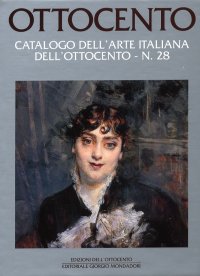Giovanni Boldini. Il Piacere
Rovereto, Mart, November 14, 2020 - February 28, 2021.
Edited by Beatrice Avanzi and Tiziano Panconi.
Genova, 2020; paperback, pp. 368, col. ill., col. plates, cm 24x28.
cover price: € 54.00
|
Books included in the offer:
Giovanni Boldini. Il Piacere
Rovereto, Mart, November 14, 2020 - February 28, 2021.
Edited by Beatrice Avanzi and Tiziano Panconi.
Genova, 2020; paperback, pp. 368, col. ill., col. plates, cm 24x28.
FREE (cover price: € 54.00)
Ottocento. Catalogo dell'Arte Italiana dell'Ottocento. Vol. 30
Milano, 2001; paperback, pp. 495, b/w ill., col. plates, cm 22x30,5.
FREE (cover price: € 40.00)
Ottocento. Catalogo dell'arte italiana dell'Ottocento. VOL. 28
Milano, 1999; bound, pp. 800, col. plates, cm 22x30.
FREE (cover price: € 77.47)
Le Opere di Galileo Galilei. Iconografia Galileiana. Appendice. Vol. I
Gruppo Editoriale Giunti
Edited by Tognoni F.
(Edizione Nazionale di Galileo Galilei).
Firenze, 2013; paperback, pp. 624, b/w ill., cm 21x29,5.
(Edizione Nazionale di Galileo Galilei).
series: Edizione Nazionale di Galileo Galilei
ISBN: 88-09-77618-6 - EAN13: 9788809776180
Subject: Essays (Art or Architecture),Painting
Languages: 
Weight: 2 kg
The 20 volumes (in 21 tomes) of the National Edition contain all of Galileo's works, both printed and manuscript, along with his imposing correspondence and documentation on his public and private life. For its philological exactitude and wealth of documentation, the National Edition of the Works of Galileo is considered today an unrivalled model for the publishing of historical/scientific texts.
In the over one hundred years that have passed since the completion of the Favaro edition, Galileo studies have brought to light new materials of exceptional interest, which significantly supplement the ample documentation published in the National Edition. In view of this, an updating project has been implemented to make new and crucially important resources available to scholars.
The updating project includes four volumes: - Iconografia galileiana [Galilean Iconography], edited by F. Tognoni - Galileo e l'Inquisizione [Galileo and the Inquisition], edited by F. Beretta - Carteggio e documenti [Correspondence and Documents], edited by M. Bucciantini, M. Camerota, P. Ruffo (two tomes) - Testi [Texts], edited by M. Helbing, G. Ernst Vol. 1 - Iconografia galileiana [Galilean Iconography] - edited by Federico Tognoni Galileo and the fortune of his oeuvre represent an exemplary cultural phenomenon. Still today, Galileo is seen as symbolising the modern intellectual, free from prejudice, the hero and martyr of libertas philosophandi. The reproductions of his image, employed to transmit artistic values and to convey particular cultural and historiographic significance, have substantially contributing to this exceptional story.
Documented for the first time in this volume is the enormous success of Galilean iconography, as shown by a remarkable series of paintings, engravings, sculptures and medallions, often of highest quality, produced without a break from the early 17th century almost to our own day. Through this visual evidence, demonstrating the constant empathetic attention of artists to the Italian scientist, we can trace the development of the legendary view of Galileo as philosopher, scientist, and discoverer of the secrets of nature, endowed with superior intellectual and moral qualities.











